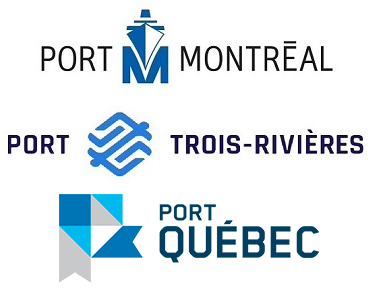
The Ports of Montreal, Québec and Trois-Rivières Look to Jointly Strengthen the St. Lawrence Corridor
Press release
A favourable context
“Global supply chains are being restructured. Shipping lines and import-export stakeholders are looking for the best routes at the best cost and want to accelerate the decarbonization of maritime transport. There are opportunities for our ports and for our economy,” said Martin Imbleau, President and CEO of the Montreal Port Authority.
“More than 80% of trade worldwide is done by ship and the St. Lawrence/Great Lakes axis is Canada’s most important trade corridor. Our infrastructures are vital to our economy, with major importance along the St. Lawrence, but of minor importance when it comes to global supply chains. With this new relationship, we want to develop some of the most sustainable and eco-responsible logistics and supply chains globally and interprovincially,” says Mario Girard, President and CEO of the Quebec Port Authority.
From west to east over 250 km of waterway, the ports of Montreal, Trois-Rivières and Québec have a lot in common. They are jointly responsible for the safe operation of traffic on one of the most beautiful rivers in the world. They serve intersecting economic and social ecosystems; they rely on complementary intermodal platforms and often have the same maritime partners. “What facilitates collaboration is our complementarity. The ports of Montréal, Québec and Trois-Rivières each have their own expertise and specific roles in the supply chain. Increasing our collaboration will create synergies that will benefit the customers we serve and the communities in which we operate,” says Gaétan Boivin, President and CEO of the Trois-Rivières Port Authority.
Recommendations from now until the year’s end
The working group will explore different avenues of collaboration that could improve the competitiveness of the St. Lawrence corridor, such as the connection between the ports and the freight and train transport networks, the exchange of expertise, or the compatibility of technological systems. Since the Government of Canada has announced its intention to modernize the Canada Marine Act, the act that governs the canadian Port Authorities’ operations, the working group’s conclusions could also be used to inform the work of Transport Canada.
Operated by the Montreal Port Authority (MPA), the Port of Montreal is the second-largest port in Canada and a diversified transhipment centre that handles all types of cargo. The only container port in Quebec, it is a destination port served by the largest shipping lines in the world. The MPA integrates the economic, social and environmental aspects into its business approaches. This commitment is supported by a sustainable development policy, whose guiding principles are involvement, cooperation and transparency. Active since 1882, the Port of Trois-Rivières is an important player in regional, national and international economic development for major industrial sectors such as the aluminum industry, forestry and agri-food. Annually, the Port of Trois-Rivières welcomes merchant and cruise ships originating from over 100 different ports in more than 40 countries around the world. Among the five largest ports in Canada in terms of tonnage handled and economic benefits, the Port of Québec is strategically located to serve the heart of North America. It is the only port that has both deep-water requirements and complete intermodality. Thus, it is able to receive cargo without constraint from or destined to some fifty countries in order to connect the Quebec, Great Lakes and American Midwest markets to the rest of the world.About the Port of Montreal
About the Port of Trois-Rivières
About the Port of Québec
— 30 —
For information
Frédérique Lorrain
Consultant
TACT
Cellphone: 450-702-0339



